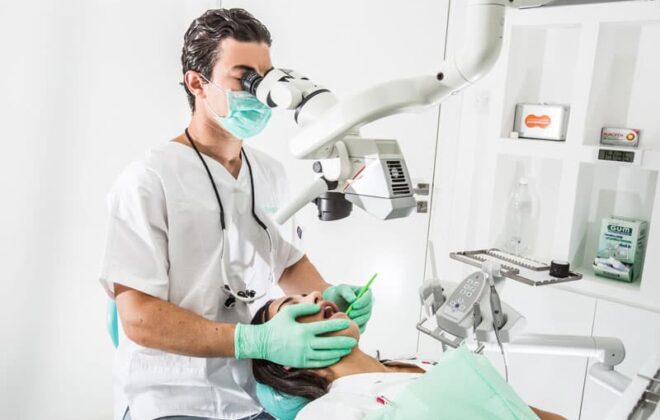7 Signs You Need a Root Canal and How to Spot Infection After Treatment
Root canals are a common and effective dental procedure to treat and save severely damaged or infected teeth from gum disease, tooth decay, and injury. They involve removing the infected pulp, cleaning, and sealing the tooth to prevent re-infection.
The pulp contains nerves, blood vessels, and connective tissue that can become infected when exposed to bacteria. Postponing treatment can cause bacteria to spread, causing tooth loss, bone loss, or a dental abscess that requires more extensive and expensive treatments.
Many people are wary of root canals, but the process is virtually painless since you will be under local anesthetic. The dentist will determine if you need a root canal based on your symptoms, the extent of the damage, and the degree of infection.
It is important, however, to be aware of the signs that may require a root canal so that you can seek treatment as soon as possible. Read on to learn the most common signs that you may need a root canal treatment and how to spot any infection after.
What Happens During a Root Canal?
A root canal procedure is performed by a dentist or, in more complex cases, an endodontist – a specialist in diagnosing and treating dental pulp-related conditions. They will take dental X-rays to determine the extent of tooth decay, infection, and damage. The dentist will then numb the area with a local anesthetic, drill a hole in the tooth, and remove the infected pulp.
The area is then cleaned, sealed, and filled with a rubbery material called gutta-percha. The dentist will then place a crown over the tooth to strengthen and protect it from further damage. Root canal therapy takes 2 to 3 visits, depending on the severity of the infection, and can last anywhere from 30 minutes to 90 minutes.
7 Signs You Need a Root Canal
Common signs that may necessitate a root canal include:
1. Excruciating Pain When Chewing or Biting
Severe chewing or biting pain is usually a sign of internal nerve damage. It is caused by pressure imparted on the infected pulp, triggering the nerve endings in the area. The pain is usually sharp, throbbing, or shooting and can radiate to your jaw, face, or other teeth.
2. Sensitivity to Hot and Cold Temperatures
If you experience sensitivity when consuming hot or cold beverages or food, it’s likely a sign of an infection in the pulp. Extreme temperatures irritate the nerve endings, causing pain and discomfort. The sensitivity manifests as a sharp, throbbing pain or a dull ache that lingers even after consuming the food or beverage.
3. Swelling and Tenderness in the Gums
Infection in the tooth pulp can cause swelling and tenderness in the gums. The tissue around the root tip may be swollen, inflamed, and pressure-sensitive. There may also be a pimple-like bump on the gums that may ooze pus, causing bad breath and an unpleasant taste in the mouth.
4. Discoloration and Darkening of the Tooth
The pulp contains blood vessels that nourish the tooth and, when infected, induces discoloration and darkening of the tooth. A bacterial infection causes the pulp tissue to break down, creating a gray or black discoloration. The tooth becomes brittle and prone to fractures. Infected teeth may also have vertical or horizontal cracks or lines, with streaks of black, yellow, and brown hues that indicate a dying pulp.
5. Chipped or Fractured Tooth
Cracks, fractures, and chips in teeth from facial trauma or biting on hard objects can cause the pulp to become exposed, allowing bacteria and other debris to enter. This triggers an infection that causes pain and inflammation in the area. It’s critical to seek medical attention even if you don’t experience any fractures or cracks, as the impact can damage the nerves and compromise the tooth’s overall health.
6. Persistent Bad Breath or a Bad Taste in Your Mouth
Persistent bad breath or taste in your mouth is usually caused by an infection that has spread to the soft tissue and other areas of the mouth. The decaying tissue releases puss and a foul odor, causing bad breath or taste. You may follow a proper dental hygiene routine and use mouthwash, yet still experience bad breath due to an underlying infection. A root canal treatment is necessary to eliminate the infection and restore fresh breath.
7. Tooth Mobility or Loose Teeth
The infection can weaken the surrounding bone, causing tooth mobility or loose teeth. Acidic waste products released by the bacteria can also erode the bone and cause it to break down. The tooth becomes wiggly or loose, making it difficult to chew and speak. Other conditions like periodontitis might cause loose teeth, so it is vital to seek a diagnosis from your dentist.
Root canal treatments can effectively eliminate pain, restore the health and aesthetics of the affected tooth, and prevent further infection. Poorly done root canals, however, are prone to re-infection, compromising the health of surrounding teeth and gums.
Signs of Infection After Root Canal Therapy
Modern root canal treatment is highly effective, but watching for signs of infection after the procedure is critical. Root canal infection occurs due to inadequate cleaning or sealing of the root canals, allowing bacteria to enter and cause infection. Neglecting post-operation care further aggravates the infection.
Common root canal symptoms to look out for include:
- Persistent pain and sensitivity a few days after the procedure
- Recurring pimples on the gum tissue around the affected area
- Inflammation and swelling in the gums near the infection site
- High fever
- Chronic bad breath or a bad taste in the mouth
- Burning sensation in the affected area
Book an appointment with your dentist immediately if you experience any of the above symptoms. The dentist will perform an X-ray to evaluate the cause of the infection and the extent of damage, then recommend the right treatment plan. They may also prescribe antibiotics or perform endodontic therapy to eliminate the infection and restore oral health.
Root canal treatments can be intimidating, but they provide an effective solution to restoring the health of your teeth. Understanding the signs of an infected tooth or post-procedure infection is critical to avoiding severe damage and saving your teeth from extraction. Proper diagnosis and treatment will help you preserve optimal oral health to enjoy a beautiful and healthy smile.
Article originally appeared at: https://thedentalteam.ca/
Author: David Meisels



